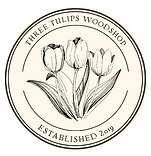my tried and true technique for success every time!
Alright. So you’ve finished your project–maybe it’s a tray, a table, a fancy built in bookshelf or cabinet, or literally anything you can think of. You’ve reached the point it’s time to finish it and you’re feeling creative and want to learn to create a distressed wood finish.
There are a number of ways you can achieve a distressed look on your wood project. Rather than leave you pondering which technique to try and have you searching for the pros and cons of all the options, I’m going to jump into sharing my ‘go to’ technique for when I’m working to create this look and hopefully have you on your way to finishing your project in minutes rather than reading a blog by someone you’ve stumbled upon on the internet…
Materials Needed:
Sand Paper
Wood Stain (I use Varathane Dark Walnut)
Petroleum Jelly
White Spray Paint
Old Cloth/Rag

step 1 - sand:
If you haven’t already, sand your project to your desired grit. I usually finish to a 120 grit unless I need a more ‘polished’ look. Electric sanders are great but hand sanding does the job too!

Step 2 - stain:
Stain your project your desired color using either oil or water based stain. This will be the base color and you will only see this in the areas you plan to distress in the next step. I personally love using Dark Walnut from Varathane (found at Home Depot) for this step. But choose a look that works for you and what you’re hoping to achieve. The options are literally endless–I’m assuming creativity excites you if you’re reading this so have fun with it! The stain aisle in your local big box store or hardware store will definitely feed your excitement here….
Wipe all excess stain after applying. Let your stain dry for 24 hours (this will take less time if you use water based stain).

Step 3-apply petroleum jelly:
Once the stain is dry, grab your petroleum jelly. Apply this to any area on your project that you want your base color to show through. I like to focus on the corners and edges, but also sneak it on elsewhere (blotches on a table top or tray, etc). It’s totally up to you. Don’t be concerned about being exact or particular. Distressing shouldn’t look like you had a plan! Which is why I excel here–I rarely have one.

Step 4 - Spray paint:
Now that the petroleum jelly is applied to your base layer, you’ll need your spray paint. I tend to use white, but this is another area where you can let your creativity soar to achieve your own look. Working in a well ventilated area (preferably outside!), spray your project. Make sure to protect the areas around you while spraying. I try to cover the entire project thoroughly, but don’t worry about a few lighter coverage areas as our goal is a distressed look anyway! Let your paint dry thoroughly.
Step 5 - wipe off spray paint:
Take a clean old rag or paper towel and start wiping the areas where you applied your petroleum jelly. You can use sandpaper as well, but it usually isn’t necessary. The spray paint will wipe right off these areas and leave behind a distressed look.

Step 6 - you're done:
There isn’t one. That’s it. Super simple, super effective, super amazing. Admire yourself.
Additional Thoughts:
If you’re good to go with the process, no need to read on! My goal is truly to get you back to your project as fast as possible. But if you have any interest in my parting thoughts, stay with me.
There are obviously a number of ways to achieve your distressed look. I’ve found this to be one of the fastest, easiest, and most effective ways for me to finish a piece after trying out a few techniques. So play around with this technique and report back to me on your thoughts. I’m not an expert and I’d love to learn from you too!
I personally like to go with a very classic distressed look with brown and white, but your options for color combinations are crazy endless. So, I’d love to see your color combinations if you branch out and get creative. I’m always looking for inspiration too!
Good luck and have fun! The beauty of distressing wood is it’s realllyyy hard to mess up the look when your entire goal is to mess up your finish. So play around and I bet you’ll love your results!






Comentários